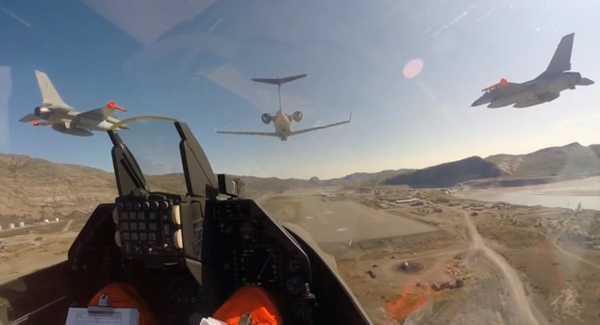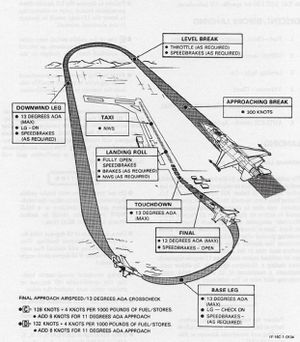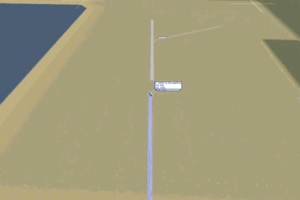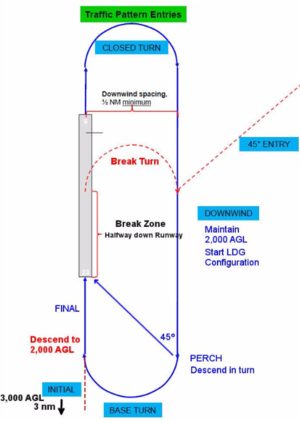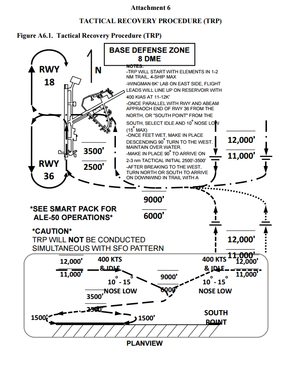Difference between revisions of "Airport operations"
| (10 intermediate revisions by 2 users not shown) | |||
| Line 10: | Line 10: | ||
=Learning files= | =Learning files= | ||
* https://www.dropbox.com/s/6yk0g0zlrgal2ss/UOAF_Landing_Procedures_v1.pdf?dl=0 | * https://www.dropbox.com/s/6yk0g0zlrgal2ss/UOAF_Landing_Procedures_v1.pdf?dl=0 | ||
| + | * [http://www.vitaf.it/AMVI_Sito/Resource/Manuals/T-6_afman11-248.pdf USAF FTM 11-248] | ||
| + | * [https://www.youtube.com/watch?v=jJe9cfGu1ac Flying a Full Procedure Approach in Falcon BMS] | ||
=Recoveries= | =Recoveries= | ||
| Line 20: | Line 22: | ||
*'''Deconflict traffic'''. Landing aircraft will automatically and intuitively deconflict with one another with minimal loss of SA when altitude and DME restrictions are observed. | *'''Deconflict traffic'''. Landing aircraft will automatically and intuitively deconflict with one another with minimal loss of SA when altitude and DME restrictions are observed. | ||
*'''Time'''. It is possible to land many aircraft safely within a small period of time in the military pattern format. | *'''Time'''. It is possible to land many aircraft safely within a small period of time in the military pattern format. | ||
| − | *'''Configuration'''. Flying the military pattern allows pilots to configure their aircraft for landing in an efficient and safe manner. At a minimum, two turns are conducted that are used to bleed off airspeed (Ops Limit for LDG Gear 300 KIAS, 11 degree AoA or green donut for approach). | + | *'''Configuration'''. Flying the military pattern allows pilots to configure their aircraft for landing in an efficient and safe manner. At a minimum, two turns are conducted that are used to bleed off airspeed (Ops Limit for LDG Gear '''300 KIAS''', '''11''' degree AoA or '''green donut''' for approach). |
===Terminology=== | ===Terminology=== | ||
| Line 26: | Line 28: | ||
*'''Altimeter''': An aircraft instrument that measures vertical distance. For all military pattern operations, altimeters will be set to the local altimeter setting, otherwise known as QNH. If no altimeter setting can be retrieved, set the altitude to the known airfield elevation above MSL. | *'''Altimeter''': An aircraft instrument that measures vertical distance. For all military pattern operations, altimeters will be set to the local altimeter setting, otherwise known as QNH. If no altimeter setting can be retrieved, set the altitude to the known airfield elevation above MSL. | ||
*'''Entry''': The military pattern is always entered at an entry point. There are two entry points: | *'''Entry''': The military pattern is always entered at an entry point. There are two entry points: | ||
| − | **'''Initial''': A theoretical point | + | **'''Initial''': A theoretical point '''2.0 nm''' and '''2,000 AGL''' in front of and directly aligned with the active runway threshold. |
| − | **''' | + | **'''Straight In''': Straight ins are always flown |
| − | *'''Break Turn''': A continuous, constant altitude, 180 degree left or right turn executed by the flight leader at the halfway mark of the active runway. The rollout point is the downwind leg. | + | *'''Break Turn''': A continuous, '''3G''', '''70''' degree angle of bank, constant altitude, '''180''' degree left or right turn flown at '''300 knots''' and executed by the flight leader at the halfway mark of the active runway. The rollout point is the downwind leg. |
| − | * '''Downwind''': A leg of the military pattern, flown in the opposite direction and parallel of the active runway at constant altitude | + | * '''Downwind''': A leg of the military pattern, flown in the opposite direction and parallel of the active runway at constant altitude. Airspeed should be gradually reduced to '''200 knots by the perch point''' and '''gear should be dow'''n once '''abeam the halfway point of the runway'''. |
[[File:ob_overhead.png|thumb|right|Overhead break]] | [[File:ob_overhead.png|thumb|right|Overhead break]] | ||
*'''Perch''': An imaginary point on the downwind leg so that if a line were drawn from the aircraft to the runway threshold, its angle would be roughly 45 degrees. | *'''Perch''': An imaginary point on the downwind leg so that if a line were drawn from the aircraft to the runway threshold, its angle would be roughly 45 degrees. | ||
| − | *'''Base Turn''': A continuous, descending 180 degree turn from the perch point to an imaginary line extending from the runway threshhold. The rollout point is when the aircraft is aligned with the runway. | + | *'''Base Turn''': A continuous, descending 180 degree turn with '''45 degrees of bank''' and '''on speed AoA''' from the perch point to an imaginary line extending from the runway threshhold. The rollout point is when the aircraft is aligned with the runway. |
| − | *'''Final''': A point just before landing in which the aircraft is aligned with the runway, in a landing configuration, and the pilot is | + | *'''Final''': A point just before landing in which the aircraft is aligned with the runway, in a landing configuration, and the pilot is committed to the landing. |
*'''Closed Turn''': A continuous, ascending 180 degree turn from the end of the runway to intercept downwind. A closed turn is only made if going around or performing touch and go’s. | *'''Closed Turn''': A continuous, ascending 180 degree turn from the end of the runway to intercept downwind. A closed turn is only made if going around or performing touch and go’s. | ||
| Line 44: | Line 46: | ||
===UOAF Observed Parameters (SOPs)=== | ===UOAF Observed Parameters (SOPs)=== | ||
| − | *Initial will be declared at | + | *Initial will be declared at '''2.0 nm''' from the active runway threshold and will be overflown at an altitude of '''2,000 AGL'''. |
| − | *Pattern Altitude will be 2,000 AGL | + | *Prior to Initial, a flight must be established in echelon formation and on runway heading '''no later than 5.0 nm from the runway threshold'''. |
| − | *Airspeed at initial will be | + | *Pattern Altitude will be '''2,000 AGL''' at all stations unless noted or briefed otherwise. |
| + | *Airspeed at initial will be '''300 KIAS''' or slower (ops limits will be observed for all procedures) | ||
*Communications will be accurately and deliberately executed (document will explain in detail below). | *Communications will be accurately and deliberately executed (document will explain in detail below). | ||
| − | *Altitudes | + | *Altitudes for all airport operations will be referenced in MSL. Convert AGL to MSL by adding AGL values to airport elevation. |
===UOAF Procedures (SOPs)=== | ===UOAF Procedures (SOPs)=== | ||
| − | [[ | + | [[File:OHB chase view.gif |thumb|right|Overhead break - animated]] |
| − | A flight will assume close trail or echelon formation and will fly at | + | A flight will assume close trail or echelon formation and will fly at '''2,000 AGL''' until initial for the active runway at '''300 knots'''. Aircraft will fly through initial to the "break zone," an area defined as the halfway point of the active runway. Aircraft will pull approximately '''3G'''<nowiki/>'s at '''70''' degrees angle of bank until established on downwind. On downwind, aircraft will slow down to '''200 knots''' minimum and configure for landing so that they arrive at the perch on speed . |
| − | + | At the perch, aircraft will begin their base turn at approximately '''45''' degrees of bank, '''on AoA''' (flight path marker in bracket, usually around '''150 knots'''), and intercept the glidepath of the runway at approximately '''0.5 nm''' from the runway with the appropriate AoA. | |
| − | On downwind, aircraft will slow down and configure for landing. | ||
| − | At the perch, aircraft will begin their base turn and intercept the glidepath of the runway with the appropriate AoA. | ||
Aircraft will touchdown and land using the '''entirety of the runway'''. | Aircraft will touchdown and land using the '''entirety of the runway'''. | ||
[[File:Traffic_pattern_entries.png|thumb|right|Traffic pattern entries]] | [[File:Traffic_pattern_entries.png|thumb|right|Traffic pattern entries]] | ||
| Line 63: | Line 64: | ||
It is the flight leader’s responsibility to insure that landing procedures as they are stated here are followed with precision and purpose as well as to make proper radio calls to the flight and package comms. | It is the flight leader’s responsibility to insure that landing procedures as they are stated here are followed with precision and purpose as well as to make proper radio calls to the flight and package comms. | ||
====Wingmen==== | ====Wingmen==== | ||
| − | It is the | + | It is the wingman’s responsibility to "be there." Do not hit #1, keep #1 in sight, be in position and on the proper radio frequency, clear for the formation, back up #1. |
===UOAF Communications (SOPs)=== | ===UOAF Communications (SOPs)=== | ||
====Before Initial==== | ====Before Initial==== | ||
| − | *Flight leader will brief | + | *Flight leader will brief the preferred landing method to the flight (via initial, singleton straight in, formation straight in). The flight leader and wingmen are expected to know the UOAF SOP's regarding the overhead break, so no specifics are required. (Note: Entering the pattern via initial will not be flown if in IMC [Instrument Meterlogical Conditions], if there is an emergency, or if an aircraft is carrying live bombs). |
| − | **Example: “Flight, landing runway THREE- | + | **Example: “Flight, landing runway THREE-ZERO via initial.” |
| + | ** Example: “Flight, landing runway TWO-ONE via straight in, formation landing.” | ||
| + | ** Example: “Flight, landing runway ONE-FOUR via straight in, single ship.” | ||
*Wingmen will respond with their callsign. | *Wingmen will respond with their callsign. | ||
**Example: “TWO, THREE, FOUR” | **Example: “TWO, THREE, FOUR” | ||
| Line 74: | Line 77: | ||
====At Initial==== | ====At Initial==== | ||
*Flight leader will announce on package comms that his/her flight is at initial and descending to pattern altitude | *Flight leader will announce on package comms that his/her flight is at initial and descending to pattern altitude | ||
| − | **Example: “Snake 11, initial | + | **Example: “Snake 11, initial" |
| − | |||
| − | |||
====At the Break Point==== | ====At the Break Point==== | ||
*Flight leader will announce to his flight that he is executing his/her break turn | *Flight leader will announce to his flight that he is executing his/her break turn | ||
| − | **Example: “Lead | + | **Example: “Lead, in the break” |
*Wingmen will fly runway heading until it is their turn to break. After which, they will announce their break turn. | *Wingmen will fly runway heading until it is their turn to break. After which, they will announce their break turn. | ||
| − | **Example:( | + | **Example:(5 seconds later after lead’s break)“TWO, in the break” |
| − | **Example:( | + | **Example:(5 seconds later after #2’s break) “THREE, in the break” |
| − | **Example:( | + | **Example:(5 seconds later after #3’s break) “FOUR, in the break” |
====On the Downwind Leg==== | ====On the Downwind Leg==== | ||
| − | *Flight leader will communicate his/her airspeed to the | + | *Flight leader will communicate his/her airspeed while on downwind '''as a courtesy only'''. Aircraft will gradually slow from '''300 knots''' before the break turn to '''200 knots''' at the perch point on downwind. |
| − | **Example: “Lead is | + | **Example: “Lead is TWO-FIVE-ZERO knots, slowing to TWO-ZERO-ZERO." |
| − | *Wingmen will | + | *Wingmen will '''configure when approximately abeam the halfway point of the runway''' on downwind. |
| − | ** | + | **No communication is needed until reaching the perch point where a gear down call must be made (explained below). |
| − | **As a wingman, it is important to use common sense when deciding to extend boards and drop gear. Maintaining separation is paramount, but so is making sure you | + | **As a wingman, it is important to use common sense when deciding to extend boards and drop gear. Maintaining separation is paramount, but so is making sure you are equally spaced with lead and the wingmen behind you. |
====On BaseTurn==== | ====On BaseTurn==== | ||
| − | *Flight leader will communicate to the rest of the package that he/she is on the base turn | + | *Flight leader and all wingmen will communicate to the rest of the package that he/she is on the base turn. |
| − | **Example: “Snake 11, base,runway THREE-ZERO | + | **Example: “Snake 11, base, runway THREE-ZERO |
| − | + | **Example: “Snake 12, base, runway THREE-ZERO.” | |
| − | **Example: | ||
====After Touchdown==== | ====After Touchdown==== | ||
| − | *Flight leader will communicate with the rest of the | + | *Flight leader will communicate with the rest of the package that he has vacated the active runway. The rest of the package will be notified once all planes are down. |
| − | **Example: | + | **Example: “Snake 11 is off runway THREE-ZERO at Bravo.” |
| − | **Example: “Snake | + | **Example: “Snake 12 is off runway THREE-ZERO at Bravo." |
| − | |||
| − | |||
===Conclusion=== | ===Conclusion=== | ||
| Line 112: | Line 110: | ||
[[File:trp.png|thumb|right|Tactical recovery procedure (TRP)]] | [[File:trp.png|thumb|right|Tactical recovery procedure (TRP)]] | ||
How to execute a TRP | How to execute a TRP | ||
| + | |||
| + | {{Nav UOAF}} | ||
| + | |||
[[Category:UOAF]] | [[Category:UOAF]] | ||
[[Category:UOAF: BMS Codex]] | [[Category:UOAF: BMS Codex]] | ||
Latest revision as of 03:10, 22 March 2017
Contents
Learning objectives
- Enter the pattern
- Fly a circuit
- Fly the overhead break
- Fly the tactical recover procedure
- QNH vs. QFE
Learning files
- https://www.dropbox.com/s/6yk0g0zlrgal2ss/UOAF_Landing_Procedures_v1.pdf?dl=0
- USAF FTM 11-248
- Flying a Full Procedure Approach in Falcon BMS
Recoveries
Overhead break
The military pattern, otherwise known as the overhead break, is the standard for all USAF fighter operations. It looks great on camera, but primarily, it's designed to deconflict and get planes on the ground as soon as possible.
Theory
The overhead break, otherwise known as the military pattern, is a landing technique used to accomplish the following objectives:
- Deconflict traffic. Landing aircraft will automatically and intuitively deconflict with one another with minimal loss of SA when altitude and DME restrictions are observed.
- Time. It is possible to land many aircraft safely within a small period of time in the military pattern format.
- Configuration. Flying the military pattern allows pilots to configure their aircraft for landing in an efficient and safe manner. At a minimum, two turns are conducted that are used to bleed off airspeed (Ops Limit for LDG Gear 300 KIAS, 11 degree AoA or green donut for approach).
Terminology
- Pattern Altitude: The altitude in MSL by which an aircraft flies the downwind part of the military pattern.
- Altimeter: An aircraft instrument that measures vertical distance. For all military pattern operations, altimeters will be set to the local altimeter setting, otherwise known as QNH. If no altimeter setting can be retrieved, set the altitude to the known airfield elevation above MSL.
- Entry: The military pattern is always entered at an entry point. There are two entry points:
- Initial: A theoretical point 2.0 nm and 2,000 AGL in front of and directly aligned with the active runway threshold.
- Straight In: Straight ins are always flown
- Break Turn: A continuous, 3G, 70 degree angle of bank, constant altitude, 180 degree left or right turn flown at 300 knots and executed by the flight leader at the halfway mark of the active runway. The rollout point is the downwind leg.
- Downwind: A leg of the military pattern, flown in the opposite direction and parallel of the active runway at constant altitude. Airspeed should be gradually reduced to 200 knots by the perch point and gear should be down once abeam the halfway point of the runway.
- Perch: An imaginary point on the downwind leg so that if a line were drawn from the aircraft to the runway threshold, its angle would be roughly 45 degrees.
- Base Turn: A continuous, descending 180 degree turn with 45 degrees of bank and on speed AoA from the perch point to an imaginary line extending from the runway threshhold. The rollout point is when the aircraft is aligned with the runway.
- Final: A point just before landing in which the aircraft is aligned with the runway, in a landing configuration, and the pilot is committed to the landing.
- Closed Turn: A continuous, ascending 180 degree turn from the end of the runway to intercept downwind. A closed turn is only made if going around or performing touch and go’s.
Restrictions
The military pattern is flown under several conditions:
- VFR Weather Conditions (3 statute mile visibility, cloud clearances of 500 feet below, 1,000 feet above, and 2,000 feet horizontal distance).
- IFR conditions are NOT present and no instrument approaches are in effect
- No emergency procedures are in effect for aircraft in the flight or other landing aircraft.
- In multiple ship flights, indivudal ships will break at a briefed time interval with respect to the flight leader.
UOAF Observed Parameters (SOPs)
- Initial will be declared at 2.0 nm from the active runway threshold and will be overflown at an altitude of 2,000 AGL.
- Prior to Initial, a flight must be established in echelon formation and on runway heading no later than 5.0 nm from the runway threshold.
- Pattern Altitude will be 2,000 AGL at all stations unless noted or briefed otherwise.
- Airspeed at initial will be 300 KIAS or slower (ops limits will be observed for all procedures)
- Communications will be accurately and deliberately executed (document will explain in detail below).
- Altitudes for all airport operations will be referenced in MSL. Convert AGL to MSL by adding AGL values to airport elevation.
UOAF Procedures (SOPs)
A flight will assume close trail or echelon formation and will fly at 2,000 AGL until initial for the active runway at 300 knots. Aircraft will fly through initial to the "break zone," an area defined as the halfway point of the active runway. Aircraft will pull approximately 3G's at 70 degrees angle of bank until established on downwind. On downwind, aircraft will slow down to 200 knots minimum and configure for landing so that they arrive at the perch on speed . At the perch, aircraft will begin their base turn at approximately 45 degrees of bank, on AoA (flight path marker in bracket, usually around 150 knots), and intercept the glidepath of the runway at approximately 0.5 nm from the runway with the appropriate AoA. Aircraft will touchdown and land using the entirety of the runway.
Responsibilities
Flight Leaders
It is the flight leader’s responsibility to insure that landing procedures as they are stated here are followed with precision and purpose as well as to make proper radio calls to the flight and package comms.
Wingmen
It is the wingman’s responsibility to "be there." Do not hit #1, keep #1 in sight, be in position and on the proper radio frequency, clear for the formation, back up #1.
UOAF Communications (SOPs)
Before Initial
- Flight leader will brief the preferred landing method to the flight (via initial, singleton straight in, formation straight in). The flight leader and wingmen are expected to know the UOAF SOP's regarding the overhead break, so no specifics are required. (Note: Entering the pattern via initial will not be flown if in IMC [Instrument Meterlogical Conditions], if there is an emergency, or if an aircraft is carrying live bombs).
- Example: “Flight, landing runway THREE-ZERO via initial.”
- Example: “Flight, landing runway TWO-ONE via straight in, formation landing.”
- Example: “Flight, landing runway ONE-FOUR via straight in, single ship.”
- Wingmen will respond with their callsign.
- Example: “TWO, THREE, FOUR”
At Initial
- Flight leader will announce on package comms that his/her flight is at initial and descending to pattern altitude
- Example: “Snake 11, initial"
At the Break Point
- Flight leader will announce to his flight that he is executing his/her break turn
- Example: “Lead, in the break”
- Wingmen will fly runway heading until it is their turn to break. After which, they will announce their break turn.
- Example:(5 seconds later after lead’s break)“TWO, in the break”
- Example:(5 seconds later after #2’s break) “THREE, in the break”
- Example:(5 seconds later after #3’s break) “FOUR, in the break”
On the Downwind Leg
- Flight leader will communicate his/her airspeed while on downwind as a courtesy only. Aircraft will gradually slow from 300 knots before the break turn to 200 knots at the perch point on downwind.
- Example: “Lead is TWO-FIVE-ZERO knots, slowing to TWO-ZERO-ZERO."
- Wingmen will configure when approximately abeam the halfway point of the runway on downwind.
- No communication is needed until reaching the perch point where a gear down call must be made (explained below).
- As a wingman, it is important to use common sense when deciding to extend boards and drop gear. Maintaining separation is paramount, but so is making sure you are equally spaced with lead and the wingmen behind you.
On BaseTurn
- Flight leader and all wingmen will communicate to the rest of the package that he/she is on the base turn.
- Example: “Snake 11, base, runway THREE-ZERO
- Example: “Snake 12, base, runway THREE-ZERO.”
After Touchdown
- Flight leader will communicate with the rest of the package that he has vacated the active runway. The rest of the package will be notified once all planes are down.
- Example: “Snake 11 is off runway THREE-ZERO at Bravo.”
- Example: “Snake 12 is off runway THREE-ZERO at Bravo."
Conclusion
The military pattern is designed with safety and efficiency in mind. When flown accurately, the overhead break in the military pattern should be a seamless exercise in formation and communication. As long as flights dictate their intentions and locations while maintaining proper procedures, collisions and safety hazards are minimal despite airspace that is densely populated with landing aircraft.
Tactical recovery procedure (TRP)
How to execute a TRP
{{#invoke:Navbox|navbox}}
